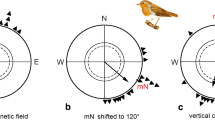Abstract
Intact pigeons (n = 19) were rotated in the dark in the horizontal plane in different orientations relative to the axis of rotation. In central (evoking habituation) rotations, the animal's head was located on the axis of rotation; in eccentric rotations, the animal's head was 0.6 m from the axis of rotation. Pigeons were subjected to series of alternating central and eccentric rotations; rotation directions were also alternated. Series consisted of 2–5 rotation using a trapezoidal program. Each stimulus evoking habituation was used no more than 14 times during the experiment. Eccentric rotations were found not to prevent the gradual decrease in the peak rates of the slow components of primary nystagmus occurring on the transition from one series of central rotations to another in 17 individuals (group 1); these were increased in two individuals (group 2). Group 1 showed direct relationships between changes in this measure of primary nystagmus, changes in the duration of nystagmus, and changes in the peak rates of secondary nystagmus. Modifications of nystagmus within series varied. When two identical stimuli did not follow immediately one after the other, the second stimulus induced the same changes in nystagmus as observed in the individual in the first and next series of central rotations. If two identical stimuli followed one immediately after the other, the second stimulus in the pair often induced increases in the peak rates of primary and secondary nystagmus, along with increases in the time taken to reach the peak rate of primary nystagmus. These changes were non-random at a probability of >95%.
Similar content being viewed by others
REFERENCES
A. E. Kurashvili and V. I. Babiyak, Physiological Functions of the Vestibular System[in Russian], Meditsina, Leningrad (1975).
M. M. Levashov, Nystagmometry in the Assessment of the State of Vestibular Function[in Russian], Nauka, Leningrad (1984).
I. V. Orlov, Vestibular Function[in Russian], Nauka, St. Petersburg (1998).
A. N. Razumeev and A. A. Shipov, Neural Mechanisms of Vestibular Responses[in Russian], Nauka, Moscow (1971).
Yu. K. Stolbkov, “Changes in nystagmus in conditions of otolith stimulation,” Fiziol. Zh. SSSR, 62, No. 9, 1317–1324 (1976).
Yu. K. Stolbkov, “Vestibular adaptation in pigeons,” in: Proceedings of the XII International Conference and the V School on Evolutionary Physiology (19–25 November 2001)[in Russian], St. Petersburg (2001), p. 142.
S. N. Khechinashvili, Vestibular Function[in Russian], Academy of Sciences of the Georgian SSR Press, Tbilisi (1958).
K. L. Khilov, Functions of the Balance Organs and Motion Sickness [in Russian], Meditsina, Leningrad (1969).
S. Ahn, C. Y. Lee, D. W. Kim, and M. H. Lee, “Short-term vestibular responses to repeated rotations,” J. Vestib. Res., 10, No. 1, 17–23 (2000).
T. J. Anastasio, “A pattern correlation model of vestibulo-ocular reflex habituation,” Neural Networks, 14, No. 1, 1–22 (2001).
J. Brown, “Interacting vestibular stimuli and nystagmus habituation,” Acta Otolaryngol., 62, 341–350 (1966).
G. Clemént, J.-M. Flandrin, and J.-H. Coujon, “Comparison between habituation of the cat vestibulo-ocular reflex by velocity steps and sinusoidal vestibular stimulation in the dark,” Exptl. Brain Res., 142, No. 2, 259–267 (2002).
H. Cohen, B. Cohen, T. Raphan, and W. Waespe, “Habituation and adaptation of the vestibuloocular reflex: a model of differential control by the vestibulocerebellum,” Exptl. Brain Res., 90, No. 3, 526–538 (1992).
W. Collins, “Effects on vestibular habituation of interrupting nystagmus responses with opposing stimuli,” J. Comp. Physiol. Psychol., 64, 308–312 (1967).
W. Collins, “Influence of head position on the habituation of vertical nystagmus in the cat,” J. Comp. Physiol. Psychol., 67, 156–159 (1969).
W. Collins and B. Updegraff, “Possible interaction between gravireceptors and semicircular canals in the habituation of vertical nystagmus in parrots,” Acta Otolaryngol., 69, 257–265 (1970).
J. Courjon, G. Clemént, and R. Schmid, “The influence of the inter-stimulus interval on the development of vestibular habituation to repeated velocity steps,” Exptl. Brain Res., 59, No. 1, 10–15 (1985).
G. H. Crampton and J. H. Brown, “Repeated vertical semicircular canal stimulation does not habituate horizontal nystagmus in the cat,” Acta Otolaryngol., 58, 441–448 (1964).
J. Demer, J. Goldberg, H. Jenkins, and F. Porter, “Vestibulo-ocular reflex during magnified vision: adaptation to reduce visual-vestibu-lar conflict,” Aviat. Space Environ. Med., 58, Supplement, A175–A179 (1987).
E. R. Dow and T. J. Anastasio, “Analysis and modeling of frequency-specific habituation of the goldfish vestibulo-ocular reflex,” J. Comput. Neurosci., 7, No. 1, 55–70 (1999).
F. Guedry, W. Collins, and A. Graybiel, “Vestibular habituation during repetitive complex stimulation: a study of transfer effects,” J. Appl. Physiol., 19, 1005–1015 (1964).
S. Lisberger, F. Miles, and L. Optican, “Frequency-selective adaptation: evidence for channels in the vestibulo-ocular reflex?” J. Neurosci., 6, 1234–1244 (1983).
R. Malkolm and G. Melvill Jones, “A quantitative study of vestibular adaptation in humans,” Acta Otolaryngol., 70, 126–135 (1970).
R. Schmid and M. Jeannerod, “Vestibular habituation: an adaptive process?” in: Adaptive Mechanisms in Gaze Control, Elsevier, Amsterdam, New York, Oxford (1985), pp. 113–122.
G. Singleton, “Relationship of the cerebellar nodules to vestibular function: a study of the effects of modulectomy on habituation,” Laryngoscope, 77, 1579–1615 (1967).
H. Suarez, B. Rosales, and C. Claussen, “Plastic properties of the vestibulo-ocular reflex in olivo-ponto-cerebellar atrophy,” Acta Otolaryngol., 112, 589–594 (1992).
M. P. Torte, G. Clément, J.-H. Coujon, and G. Magenes, “Absence of vestibular habituation of the vestibulo-ocular reflex in the vertical plane in the cat,” Exptl. Brain Res., 116, No. 1, 73–82 (1997).
W. Waespe, B. Cohen, and T. Raphan, “Role of the flocculus and paraflocculus in optokinetic nystagmus and visual-vestibular interaction: effects of lesions,” Exptl. Brain Res., 50, No. 1, 9–33 (1983).
C. Winget, A. Smith, and C. Kelly, “Effects of chronic acceleration on induced nystagmus in the fowl,” J. Appl. Physiol., 17, No. 4, 709–711 (1962).
Author information
Authors and Affiliations
Rights and permissions
About this article
Cite this article
Stolbkov, Y.K., Orlov, I.V. Habituation of Horizontal Nystagmus of the Eyes in Pigeons in Conditions of Alternating Central and Eccentric Rotations. Neurosci Behav Physiol 35, 89–96 (2005). https://doi.org/10.1023/B:NEAB.0000049655.02638.e8
Issue Date:
DOI: https://doi.org/10.1023/B:NEAB.0000049655.02638.e8




